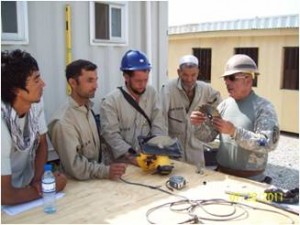Developing Afghan facility engineering is making visible progress
by Lt. Col. Ted Bernhard

Staff Sgt. Joe Campos (right), with Infrastructure Training Advisory Group, gives on the job training to Afghans on the proper use of power tools. (Photo by Cpt. Jose Rocha)
One of the current strategic objectives for the U.S.-led coalition is to field a 350,000 strong Afghan National Security Forces, including building the ANSF’s mission and support facilities. After completion, the maintenance and repair of those facilities will be a daunting task as the coalition transitions responsibility for facility sustainment to the Afghans.
NATO Training Mission-Afghanistan/Combined Security Transition Command-Afghanistan is focused on ANSF professionalization and developing their capacity for all primary and enabling functions. Within that command structure, the Combined Joint Engineer Directorate has an infrastructure training advisory group branch dedicated to developing facility engineering capabilities. ITAG’s mission is to provide training, mentorship and synchronization of operations and maintenance efforts at ANSF sites to ensure ANSF-led facility sustainment.
The scope of NTM-A’s build and maintenance effort is significant. The current and planned nationwide build effort covers six regions and more than 800 Afghan National Army and Police sites, and is valued at more than $11 billion. One of the command’s primary concerns is to protect the investment in these facilities and help promote Afghan stewardship to ensure long-term sustainability of these facilities.
Operating in an underdeveloped, dangerous environment has certainly provided challenges to our ITAG teams. ANSF facility processes and systems at the garrison, engineer department and ministerial levels are still being built. There is a critical need to build facility engineer staff capacity at all levels and address systemic problems centered on manning, training and equipping the Afghans. Having a realistic and usable budget at the garrison level is essential. ITAG teams have been a catalyst for positive change and are able to solve some of these issues in part, but more interaction on facilities issues between the Coalition and Afghan ministries is needed.
Providing on-the-job training for Afghan facility personnel has been and continues to be a big need. The trades required at each garrison are fairly standard, including masonry; carpentry; electrical; plumbing; heating, ventilation and air conditioning; metal working; painting; and generator maintenance.
ITAG has been able to oversee some of this vocational training conducted by our national operations and maintenance contractor at a centralized location in Kabul and at selected garrisons. Hands-on training seems to be the best approach, and on-site practical application has yielded the best results. For example, one ITAG team led an OJT project to build a 2,200–square-foot multi-purpose facility from start to finish. With ITAG supervision, an inexperienced Afghan crew prepped the site, placed the concrete, framed the walls and completed finish work for the entire structure. For these ANSF tradesmen, the experience was invaluable. Many used power tools for the first time in their lives and increased their building skills on a real project outside the classroom.
ITAG continues to work through training and other challenges—such as a workforce with 10-20 percent literacy—as it helps establish public works organizations throughout Afghanistan. Operational budgets; reliable logistics and supply chain systems; and the ability to recruit, train and assign facilities personnel are all critical to success.
To illustrate some of our challenges, consider recruiting for positions in maintenance. ITAG has focused on several manning initiatives. One attractive option is to have the ministries work with local vocational trade schools to set up a tailored program that would train Afghans if they sign up to work at ANSF locations for a five-year commitment. Another option is to recruit Afghan tradesmen who are working on existing U.S. contracts. Once the current nationwide infrastructure development slows down, they could migrate to ANSF positions.
Pay parity is an issue, because government positions can’t always match the current market’s pay. However, the dynamics of this solution may well work out as the economy adjusts after most major builds are completed.
Afghans are on the right path to building their capacity to sustain ANSF facilities. They are moving from an ad-hoc to a more defined process by further developing their budget, logistics and training processes. Stateside garrisons may consider some of the fundamental issues the Afghans are facing, especially as they attempt to manage and optimize their own operations with limited resources.
The ANSF is taking those first incremental steps toward managing a massive facility maintenance task. Given their dynamic and challenging environment, the Afghans really are making visible progress, and momentum is going in the right direction for the transition of infrastructure responsibility and future Afghan-led sustainment.
Lt. Col. Alan T. Bernhard is the officer in charge, ITAG Branch, Combined Joint Engineering Directorate, NTM-A/CSTC-A. <U.S. Army Corp of Engineer logo>
Acronyms and Abbreviations
ANSF – Afghan National Security Forces
CSTC-A – Combined Security Transition Command-Afghanistan
ITAG – Infrastructure Training Advisory Group
NTM-A – NATO Training Mission-Afghanistan
O&M – operations and maintenance
OJT – on-the-job training
Category: Blog - General, Blogs - Blogs
Comments (0)
Trackback URL | Comments RSS Feed
There are no comments yet. Why not be the first to speak your mind.